Floodplain Settlement Dynamics in the Maouri Dallol at Guéchémé, Niger: A Multidisciplinary Approach
Abstract
1. Introduction
2. Materials and Methods
2.1. Study Area
2.2. Rainfall Data Analysis
2.3. Hydrological Analysis and Hydraulic Modeling
2.4. Satellite-Based Settlement Dynamics
3. Results
3.1. Climatic and Hydraulic Characterization
3.2. Local Perception on Floods
3.3. Settlement Dynamics
3.4. Main Dynamics
- Building expansion (a), expressed by a strong increase in the built-up area and/or the number of buildings. The expansion was low density and the buildings used corrugated iron sheets. Angoual Chekaraou was the most significant example, with an increase of 147% in surface area, 108% in buildings, and 1300% in corrugated iron sheet roofs. The expansion occurred above all in the FPA RP20.
- Building consolidation (b), expressed by the replacement of precarious buildings with semi-permanent buildings (roofs made from corrugated iron sheets). This process reduced building density and sometimes the number of buildings. Lokoko testified to this process, with an increase of 400% in buildings with corrugated iron sheet roofs and a 23% reduction in building density.
- Expansion and building consolidation (c), expressed by an increase in the built-up area (sometimes with already semi-permanent constructions) and a building replacement of the existing fabric. Toullou, for example, increased its surface area (+35%) and replaced straw roofs (−60%) with those made from corrugated iron sheets (+350%). By virtue of building consolidation, the percentage of buildings in the FPA was unchanged.
4. Discussion
5. Conclusions
Supplementary Materials
Author Contributions
Funding
Acknowledgments
Conflicts of Interest
References
- Amogu, O.; Descroix, L.; Yéro, K.S.; Le Breton, E.; Mamadou, I.; Ali, A.; Vischel, T.; Bader, J.C.; Moussa, I.B.; Gautier, E.; et al. Increasing River Flows in the Sahel? Water 2010, 2, 170–199. [Google Scholar] [CrossRef]
- Tschakert, P.; Sagoe, R.; Ofori-Darko, G.; Codjoe, S.N.A. Floods in the Sahel: An analysis of anomalies, memory, and anticipatory learning. Climatic Change 2010, 103, 471–502. [Google Scholar] [CrossRef]
- The Emergency Events Database, EM-DAT. Available online: http://www.emdat.be/emdat_db/ (accessed on 17 April 2020).
- Fiorillo, E.; Crisci, A.; Issa, H.; Maracchi, G.; Morabito, M.; Tarchiani, V. Recent Changes of Floods and Related Impacts in Niger Based on the ANADIA Niger Flood Database. Climate 2018, 6, 59. [Google Scholar] [CrossRef]
- Tamagnone, P.; Massazza, G.; Pezzoli, A.; Rosso, M. Hydrology of the Sirba River: Updating and Analysis of Discharge Time Series. Water 2019, 11, 156. [Google Scholar] [CrossRef]
- Taylor, C.; Belušić, D.; Guichard, F.; Parker, D.J.; Vischel, T.; Bock, O.; Harris, P.P.; Janicot, S.; Klein, C.; Panthou, G. Frequency of extreme Sahelian storms tripled since 1982 in satellite observations. Nature 2017, 544, 475–478. [Google Scholar] [CrossRef] [PubMed]
- Aich, V.; Liersch, S.; Vetter, T.; Andersson, J.C.M.; Müller, E.N.; Hattermann, F.F. Climate or Land Use?—Attribution of Changes in River Flooding in the Sahel Zone. Water 2015, 7, 2796–2820. [Google Scholar] [CrossRef]
- Wilcox, C. Evaluating Hydrological Changes in Semi-Arid West Africa: Detection of Past Trends in Extremes and Framework for Modeling the Future. Ph.D. Thesis, Docteur de la Communauté Université Grenoble Alpes, Grenoble, France, 1 July 2019. [Google Scholar]
- Onywere, S.M.; Getenga, Z.M.; Mwakalila, S.S.; Twesigye, C.K. Assessing the Challenge of Settlement in Budalangi and Yala Swamp Area in Western Kenya Using Landsat Satellite Imagery. Open Environ. Eng. J. 2011, 4, 97–104. [Google Scholar] [CrossRef]
- Descroix, L.; Guichard, F.; Manuela, G.; Lambert, L.; Panthou, G.; Mahe, G.; Gal, L.; Dardel, C.; Quantin, G.; Kergoat, L.; et al. Evolution of Surface Hydrology in the Sahelo-Sudanian Strip: An Updated Review. Water 2018, 10, 748. [Google Scholar] [CrossRef]
- Praskievicz, S.; Chang, H. A review of hydrological modelling of basin-scale climate change and urban development impacts. Prog. Phys. Geogr. Earth and Environ. 2009, 33, 650–671. [Google Scholar] [CrossRef]
- Früh-Müller, A.; Wegmann, M.; Koellner, T. Erratum to: Flood exposure and settlement expansion since pre-industrial times in 1850 until 2011 in north Bavaria, Germany. Reg. Environ. Chang. 2014, 15, 183–193. [Google Scholar] [CrossRef]
- Huong, H.T.L.; Pathirana, A. Urbanization and climate change impacts on future urban flooding in Can Tho City, Vietnam. Hydrol. Earth Syst. Sci. Discussions 2011, 8, 10781–10824. [Google Scholar] [CrossRef]
- Mbow, C.; Diop, A.; Diaw, A.T.; Niang, C.I. Urban sprawl development and flooding at Yeumbeul suburb (Dakar-Senegal). Afr. J. Environ. Sci. Technol. 2008, 2, 75–88. [Google Scholar]
- IPCC. Global Warming of 1.5 °C. An IPCC Special Report on the Impacts of Global Warming of 1.5 °C above Pre-Industrial Levels and Related Global Greenhouse Gas Emission Pathways, in the Context of Strengthening the Global Response to the Threat of Climate Change, Sustainable Development, and Efforts to Eradicate Poverty; Masson-Delmotte, V., Zhai, P., Pörtner, H.-O., Roberts, D., Skea, J., Shukla, P.R., Pirani, A., Moufouma-Okia, W., Péan, C., Pidcock, R., et al., Eds.; IPCC: Geneva, Switzerland, 2018. (in press)
- Adelekan, I.O. Vulnerability of poor urban coastal communities to flooding in Lagos, Nigeria. Environ. Urban. 2010, 22, 433–450. [Google Scholar] [CrossRef]
- Tamagnone, P.; Comino, E.; Rosso, M. Rainwater harvesting techniques as an adaptation strategy for flood mitigation. J. Hydrol. 2020, 586, 124880. [Google Scholar] [CrossRef]
- UNDESA-United Nations Department of Economic and Social Affairs. World Urbanization Prospects. The 2018 Revision; United Nations: New York, NY, USA, 2018; p. 128. [Google Scholar]
- Jidauna, G.G.; Dabi, D.D.; Dia, R.Z. The effect of climate change on agricultural activities in selected settlements in the Sudano-Sahelian Region of Nigeria. Archi. Appl. Sci. Res. 2011, 3, 154–165. [Google Scholar]
- Tiepolo, M.; Braccio, S. Mainstreaming disaster risk reduction into local development plans for rural tropical Africa: A systematic assessment. Sustainability 2020, 12, 2196. [Google Scholar] [CrossRef]
- Thompson, H.E.; Berrang-Ford, L.; Ford, J.D. Climate change and food security in Sub-Saharan Africa: A systematic literature review. Sustainability 2010, 2, 2719–2733. [Google Scholar] [CrossRef]
- Connolly-Boutin, L.; Smit, B. Climate change, food security, and livelihoods in sub-Saharan Africa. Reg. Environ. Chang. 2016, 16, 385–399. [Google Scholar] [CrossRef]
- Tiepolo, M.; Rosso, M.; Massazza, G.; Belcore, E.; Issa, S.; Braccio, S. Flood Assessment for Risk-Informed Planning along the Sirba River, Niger. Sustainability 2019, 11, 4003. [Google Scholar] [CrossRef]
- Taubenböck, H.; Wurm, M.; Netzband, M.; Zwenzner, H.; Roth, A.; Rahman, A.; Dech, S. Flood risks in urbanized areas—Multi-sensoral approaches using remotely sensed data for risk assessment. Nat. Hazards Earth Syst. Sci. 2011, 11, 431–444. [Google Scholar] [CrossRef]
- Kamusoko, C.; Gamba, J. Simulating Urban Growth Using a Random Forest-Cellular Automata (RF-CA) Model. ISPRS Int. J. Geo-Inf. 2015, 4, 447–470. [Google Scholar] [CrossRef]
- Sliuzas, R.; Flacke, J.; Jetten, V. Modelling urbanization and flooding in Kampala, Uganda. In Proceedings of the 14th N-AERUS/GISDECO Conference, Enschede, The Netherlands, 12–14 September 2013; pp. 1–16. [Google Scholar]
- Popa, M.C.; Peptenatu, D.; Drăghici, C.C.; Diaconu, D.C. Flood Hazard Mapping Using the Flood and Flash-Flood Potential Index in the Buzău River Catchment, Romania. Water 2019, 11, 2116. [Google Scholar] [CrossRef]
- Annis, A.; Nardi, F.; Petroselli, A.; Apollonio, C.; Arcangeletti, E.; Tauro, F.; Belli, C.; Bianconi, R.; Grimaldi, S. UAV-DEMs for Small-Scale Flood Hazard Mapping. Water 2020, 12, 1717. [Google Scholar] [CrossRef]
- Peruzzi, C.; Castaldi, M.; Francalanci, S.; Solari, L. Three dimensional hydraulic characterisation of the Arno River in Florence. J. Flood Risk Manag. 2019, 12, 1–13. [Google Scholar] [CrossRef]
- Mohammed, T.A.; Al-Hassoun, S.; Ghazali, A.H. Prediction of Flood Levels Along a Stretch of the Langat River with Insufficient Hydrological Data. Pertanika J. Sci. Technol. 2011, 19, 237–248. [Google Scholar]
- Tarchiani, V.; Massazza, G.; Rosso, M.; Tiepolo, M.; Pezzoli, A.; Housseini Ibrahim, M.; Katiellou, G.L.; Tamagnone, P.; De Filippis, T.; Rocchi, L.; et al. Community and Impact Based Early Warning System for Flood Risk Preparedness: The Experience of the Sirba River in Niger. Sustainability 2020, 12, 1802. [Google Scholar] [CrossRef]
- Comino, E.; Dominici, L.; Ambrogio, F.; Rosso, M. Mini-hydro power plant for the improvement of urban water-energy nexus toward sustainability—A case study. J. Clean. Prod. 2020, 249, 119416. [Google Scholar] [CrossRef]
- Tamagnone, P.; Comino, E.; Rosso, M. Landscape Metrics Integrated in Hydraulic Modeling for River Restoration Planning. Environ. Model. Assess. 2020, 25, 173–185. [Google Scholar] [CrossRef]
- Güneralp, B.; Güneralp, I.; Liu, Y. Changing global patterns of urban exposure to flood and drought hazards. Glob. Environ. Chang. 2015, 31, 217–225. [Google Scholar] [CrossRef]
- Röthlisberger, V.; Zischg, A.P.; Keiler, M. Spatiotemporal aspects of flood exposure in Switzerland. In Proceedings of the E3S Web of Conferences, Lyon, France, 17–21 October 2016; pp. 1–5. [Google Scholar]
- IPCC. Climate Change 2014: Synthesis Report. Contribution of Working Groups I, II and III to the Fifth Assessment Report of the Intergovernmental Panel on Climate Change; Pachauri, R.K., Meyer, L.A., Eds.; IPCC: Geneva, Switzerland, 2014; p. 151. [Google Scholar]
- Amoako, C.; Inkoom, D.K.B. The production of flood vulnerability in Accra, Ghana: Re-thinking flooding and informal urbanisation. Urban Stud. 2018, 55, 2903–2922. [Google Scholar] [CrossRef]
- Castro Correa, C.P.; Ibarra, I.; Lukas, M.; Véliz, J.O.; Sarmiento, J.P. Disaster Risk Construction in the Progressive Consolidation of Informal Settlements: Iquique and Puerto Montt (Chile) Case Studies. Int. J. Disaster Risk Reduct. 2015, 13, 109–127. [Google Scholar] [CrossRef]
- Balasbaneh, A.T.; Abidin, A.R.Z.; Ramli, M.Z.; Khaleghi, S.J.; Marsono, A.K. Vulnerability assessment of building material against river flood water: Case study in Malaysia. In IOP Conference Series: Earth and Environmental Science, Proceeding of the 2nd International Conference on Civil & Environmental Engineering, Langkawi, Malaysia, 20–21 November 2019; IOP Publishing Ltd.: Bristol, UK, 2019; pp. 1–8. [Google Scholar]
- Dangol, N.; Day, J. Flood adaptation by informal settlers in kathmandu and their fear of eviction. Int. J. Saf. Secur. Eng. 2017, 7, 147–156. [Google Scholar] [CrossRef][Green Version]
- López, Ó.L.; Torres, I. Ventilation system for drying out buildings after a flood: Influence of the building material. Dry. Technol. 2017, 35, 867–876. [Google Scholar] [CrossRef]
- Eakin, H.; Lerner, A.M.; Murtinho, F. Adaptive capacity in evolving peri-urban spaces: Responses to flood risk in the Upper Lerma River Valley, Mexico. Glob. Environ. Chang. 2010, 20, 14–22. [Google Scholar] [CrossRef]
- Direction de la Météorologie Nationale du Niger (DMN). Guéchémé Pluviométrie 1981–2018. 2019. [Google Scholar]
- Climate Data, Dosso Climate. Available online: https://en.climate-data.org/africa/niger/dosso/dosso-26232/#temperature-graph (accessed on 8 December 2019).
- Institut National de la Statistique. Niger: Répertoire National des Localités (RENALOC), 1st ed.; Ministère des Finances: Niamey, Niger, 2014; p. 718.
- WMO Guidelines on the Definition and Monitoring of Extreme Weather and Climate Events (Final Draft). 2018. Available online: http://www.wmo.int/pages/prog/wcp/ccl/references.php (accessed on 5 May 2020).
- BDINA. Base de Données sur les Inondations Niger ANADIA. Available online: https://www.inondations-niger.org/content.php?page=32 (accessed on 5 May 2020).
- Lehner, B.; Verdin, K.; Jarvis, A. New global hydrography derived from spaceborne elevation data. Eos Trans. Am. Geophys. Union J. 2008, 89, 93–94. [Google Scholar] [CrossRef]
- USGS; WWF. Hydrological Data and Maps based on Shuttle Elevation Derivates at Multiple Scales (HydroSHEDS). Available online: https://hydrosheds.cr.usgs.gov/ (accessed on 22 March 2020).
- NASA; DRL; ASI. Shuttle Radar Topography Mission (SRTM). Available online: https://www2.jpl.nasa.gov/srtm/ (accessed on 22 March 2020).
- Woodward, D.E.; Hoeft, C.C.; Humpal, A.; Cerrelli, G. Chapter 15—Time of Concentration. In National Engineering Handbook Part 630 Hydrology; USDA Natural Resources Conservation Service, Ed.; NRCS: Fort Worth, TX, USA, 2010; pp. 1–29. [Google Scholar]
- Salimi, E.T.; Nohegar, A.; Malekian, A.; Hoseini, M.; Holisaz, A. Estimating time of concentration in large watersheds. Paddy Water Environ. 2017, 15, 123–132. [Google Scholar] [CrossRef]
- Ravazzani, G.; Boscarello, L.; Cislaghi, A.; Mancini, M. Review of Time-of-Concentration Equations and a New Proposal in Italy. J. Hydrol. Eng. 2019, 24, 04019039. [Google Scholar] [CrossRef]
- Shiau, J. Return period of bivariate distributed extreme hydrological events. Stoch. Environ. Res. Risk Assess. 2003, 17, 42–57. [Google Scholar] [CrossRef]
- Subyani, A.M. Hydrologic behavior and flood probability for selected arid basins in Makkah area, western Saudi Arabia. Arab. J. Geosci. 2011, 4, 817–824. [Google Scholar] [CrossRef]
- Thas, O.; Ottoy, J.P. Some generalizations of the Anderson–Darling statistic. Stat. Probab. Lett. 2003, 64, 255–261. [Google Scholar] [CrossRef]
- Ožanić, N.; Rubinić, J.; Karleuša, B.; Holjević, D. Problems of High Water Appearances in Urban Areas. In Proceedings of the IX International Symposium on Water Management and Hydraulic Engineering, Ottenstein, Austria, 4–7 September 2005; pp. 395–402. [Google Scholar]
- US Army Corps of Engineers—Hydrologic Engineering Center, HEC-HMS. Available online: https://www.hec.usace.army.mil/software/hec-hms/ (accessed on 18 June 2020).
- Boughton, W.C. A review of the USDA SCS curve number method. Soil Res. 1989, 27, 511–523. [Google Scholar] [CrossRef]
- Woodward, D.E.; Hawkins, R.H.; Jiang, R.; Hjelmfelt, A.T.; Van Mullem, J.A.; Quan, Q.D. Runoff Curve Number Method: Examination of the Initial Abstraction Ratio. In Proceedings of the World Water and Environmental Resources Congress 2003 and Related Symposia, Philadelphia, PA, USA, 23–26 June 2003; pp. 1–16. [Google Scholar]
- Copernicus Global Land Service: Africa Land Cover. Available online: https://africa.lcviewer.vito.be/2015 (accessed on 2 July 2020).
- Soulis, K.X.; Valiantzas, J.D. SCS-CN parameter determination using rainfall-runoff data in heterogeneous watersheds—The two-CN system approach. Hydrol. Earth Syst. Sci. 2012, 16, 1001–1015. [Google Scholar] [CrossRef]
- Ling, L.; Yusop, Z.; Yap, W.-S.; Tan, W.L.; Chow, M.F.; Ling, J.L. A Calibrated, Watershed-Specific SCS-CN Method: Application to Wangjiaqiao Watershed in the Three Gorges Area, China. Water 2020, 12, 60. [Google Scholar] [CrossRef]
- Mamadou, I.; Gautier, E.; Descroix, L.; Noma, I.; Moussa, I.B.; Maiga, O.F.; Genthon, P.; Amogu, O.; Malam Abdou, M.; Vandervaere, J. Exorheism growth as an explanation of increasing flooding in the Sahel. Catena 2015, 131, 130–139. [Google Scholar] [CrossRef]
- Massazza, G.; Tamagnone, P.; Wilcox, C.; Belcore, E.; Pezzoli, A.; Vischel, T.; Panthou, G.; Housseini Ibrahim, M.; Tiepolo, M.; Tarchiani, V.; et al. Flood Hazard Scenarios of the Sirba River (Niger): Evaluation of the Hazard Thresholds and Flooding Areas. Water 2019, 11, 1018. [Google Scholar] [CrossRef]
- US Army Corps of Engineers—Hydrologic Engineering Center, HEC-RAS. Available online: https://www.hec.usace.army.mil/software/hec-ras/ (accessed on 22 March 2020).
- Ardiçlioglu, M.; Kuriqi, A. Calibration of channel roughness in intermittent rivers using HEC-RAS model: Case of Sarimsakli creek, Turkey. SN Appl. Sci. 2019, 1, 1080. [Google Scholar] [CrossRef]
- GeoEye, GeoEye-1 Scene 010474140010, Corrected, Bundle, Longmont, Colorado, CO, USA: GeoEye, 6–14 October 2009. Available online: https://brocku.ca/library/wp-content/uploads/sites/51/MDG-How-to-Reference.pdf. (accessed on 10 July 2020).
- WorldView, WorldView-2 Scene 1030010097333C00, Corrected, Bundle, Munich, Germany: EUSI GmbH, 1–6 September 2019. Available online: https://brocku.ca/library/wp-content/uploads/sites/51/MDG-How-to-Reference.pdf. (accessed on 10 July 2020).
- ESRI. Pansharpening Function. Available online: https://pro.arcgis.com/en/pro-app/help/data/imagery/pansharpening-function.htm (accessed on 3 June 2020).
- SDSTATE. Radiometric Calibration. Available online: https://www.sdstate.edu/jerome-j-lohr-engineering/radiometric-calibration (accessed on 10 February 2020).
- ESRI. Dictionary of GIS Terminology; Karman, M., Amdahl, G., Eds.; ESRI Press: Redlands, CA, USA, 2000; p. 119. [Google Scholar]
- Yan, G.; Mas, J.-F.; Maathuis, B.H.P.; Xiangmin, Z.; Van Dijk, P.M. Comparison of pixel-based and object-oriented image classification approaches—A case study in a coal fire area, Wuda, Inner Mongolia, China. Int. J. Remote Sens. 2006, 27, 4039–4055. [Google Scholar] [CrossRef]
- Ying, T. Chapter 11—Applications. In Gpu-Based Parallel Implementation of Swarm Intelligence Algorithms, 1st ed.; Ying, T., Ed.; Morgan Kaufmann: Burlington, MA, USA, 2016; pp. 167–177. [Google Scholar]
- Harris Geospatial Solutions, Spectral Indices. Available online: https://www.harrisgeospatial.com/docs/SpectralIndices.html (accessed on 26 November 2019).
- Fernández, D.S.; Lutz, M.A. Urban flood hazard zoning in Tucumán Province, Argentina, using GIS and multicriteria decision analysis. Eng. Geol. 2010, 111, 90–98. [Google Scholar] [CrossRef]
- Casas, A.; Benito, G.; Thorndycraft, V.R.; Rico, M. The topographic data source of digital terrain models as a key element in the accuracy of hydraulic flood modelling. Earth Surf. Process. Landf. 2006, 31, 444–456. [Google Scholar] [CrossRef]
- Zouari, K.; Moulla, A.S.; Smati, A.; Adjomayi, P.A.; Boukari, M.; Thiam, A.; Kone, S.; Rabe, S.; Bobadji, I.; Maduabuchi, C.M.; et al. Integrated and Sustainable Management of Shared Aquifer Systems and Basins of the Sahel Region, Iullemeden Aquifer System; International Atomic Energy Agency (IAEA): Vienna, Austria, 2017; p. 114. [Google Scholar]
- FAO. Mission to the Sahel. Available online: http://www.fao.org/3/f7795e/f7795e05.htm (accessed on 24 June 2020).
- Tiepolo, M.; Tarchiani, V. Risque et Adaptation Climatique Dans la Région Tillabéri, Niger; L’Harmattan: Paris, France, 2016; p. 282. [Google Scholar]
- Tiepolo, M.; Bacci, M.; Braccio, S. Multihazard Risk Assessment for Planning with Climate in the Dosso Region, Niger. Climate 2018, 6, 67. [Google Scholar] [CrossRef]
- Tiepolo, M.; Braccio, S.; Tarchiani, V. Lo Sviluppo delle aree Rurali Remote: Petrolio, Uranio e Governance Locale in Niger; FrancoAngeli: Milan, Italy, 2009; p. 224. [Google Scholar]
- Okoro, B.C.; Ibe, O.P.; Ekeleme, A.C. Development of a Modified Rational Model for Flood Risk Assessment of Imo State, Nigeria Using Gis and Rs. Int. J. Eng. Sci. 2014, 3, 1–8. [Google Scholar]
- Jayne, T.S.; Chamberlin, J.; Headey, D.D. Land pressures, the evolution of farming systems, and development strategies in Africa: A synthesis. Food Policy 2014, 48, 1–17. [Google Scholar] [CrossRef]
- Tiepolo, M.; Braccio, S. 12. Flood Risk Preliminary Mapping in Niamey, Niger. In Planning to Cope with Tropical and Subtropical Climate Change, 1st ed.; Tiepolo, M., Ponte, E., Cristofori, E., Eds.; De Gruyter: Berlin, Germany, 2016; pp. 201–220. [Google Scholar]
- Mbanga, L.A. Human Settlement Dynamics in the Bamenda III Municipality, North West Region, Cameroon. J. Settl. Spat. Plan. 2018, 9, 47–58. [Google Scholar]
- Kuriqi, A.; Ardiçlioglu, M.; Muceku, Y. Investigation of seepage effect on river dike’s stability under steady state and transient conditions. Pollack Period. 2016, 11, 87–104. [Google Scholar] [CrossRef]
- Ghassemi, S.; Sandu, C.; Fiandrotti, A.; Giulio Tonolo, F.; Boccardo, P.; Francini, G.; Magli, E. Satellite Image Segmentation with Deep Residual Architectures for Time-Critical Applications. In Proceedings of the 2018 26th European Signal Processing Conference (EUSIPCO), Rome, Italy, 3–7 September 2018; pp. 2235–2239. [Google Scholar]
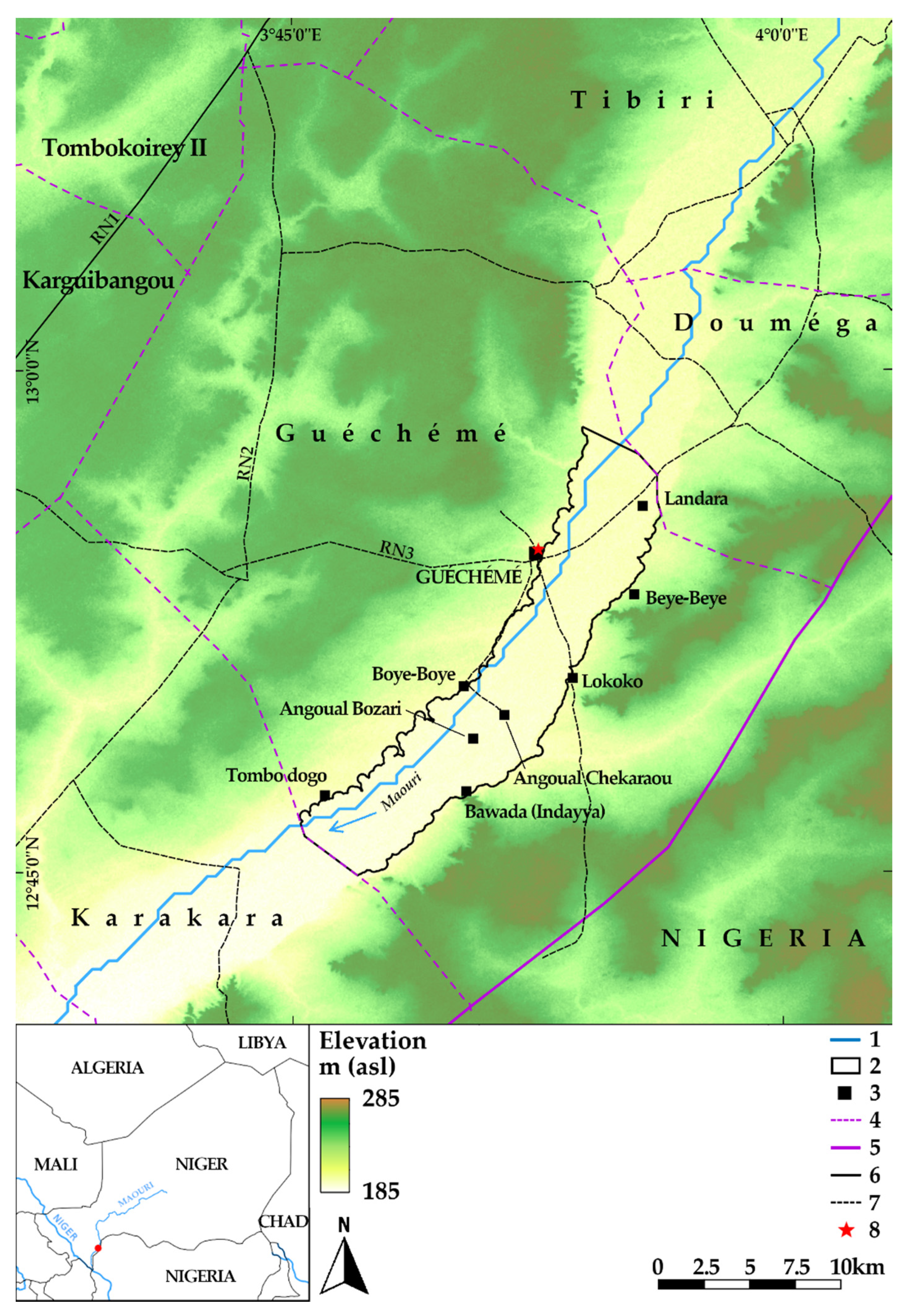
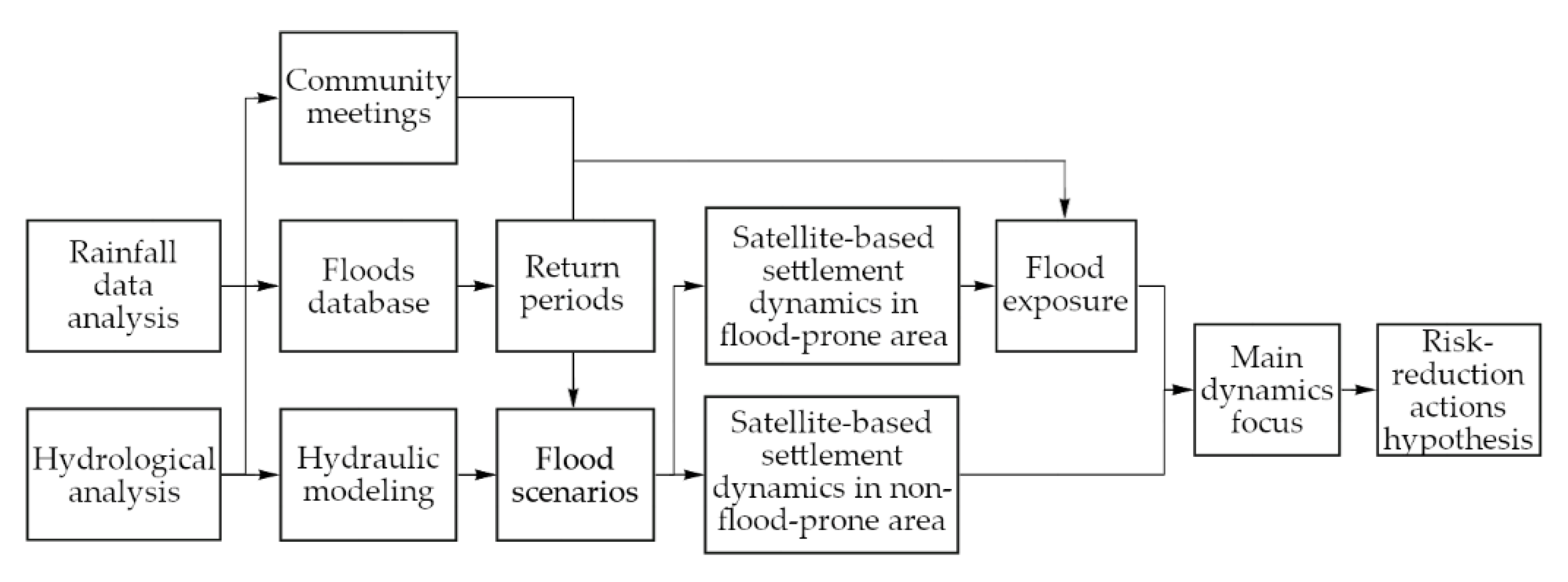
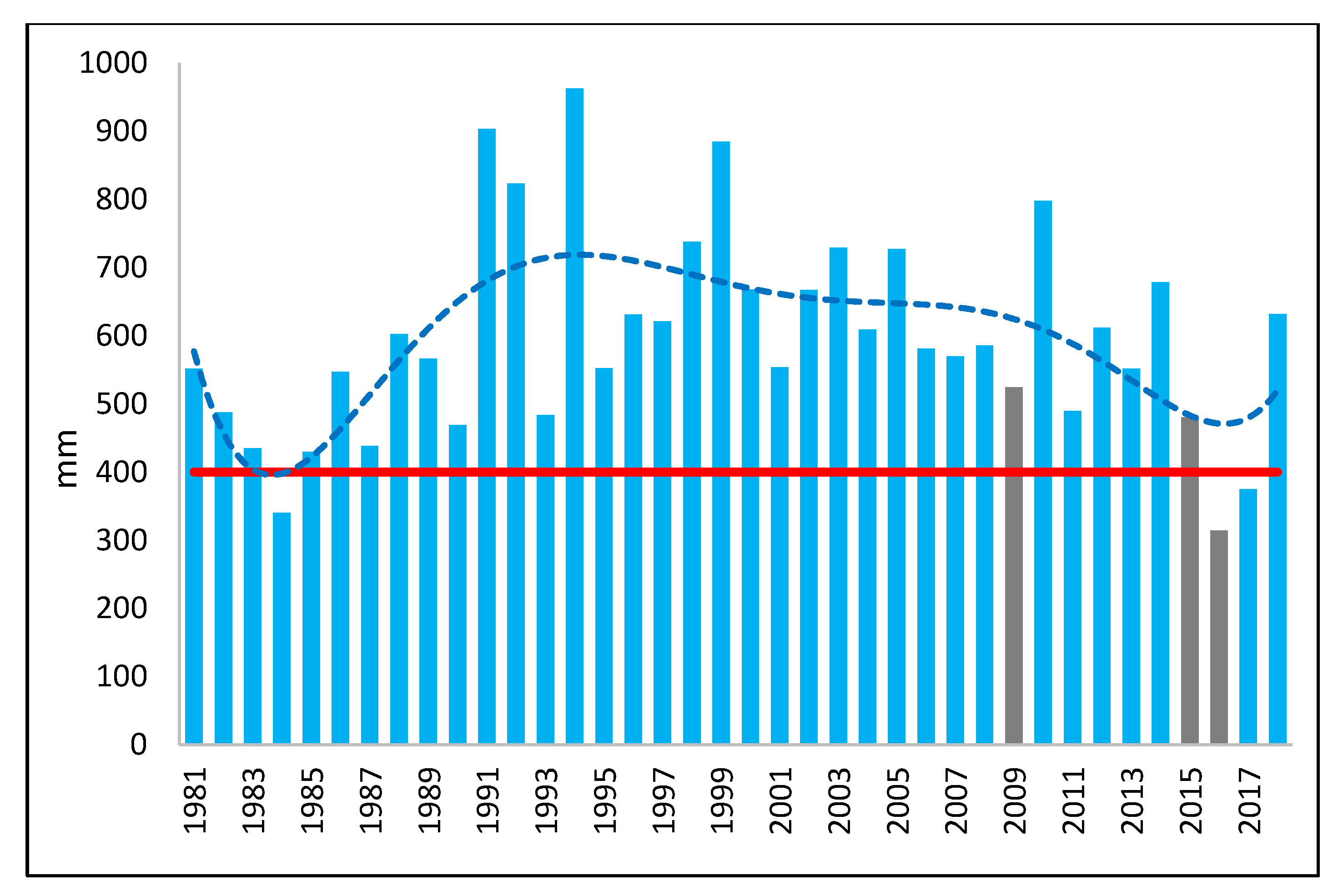
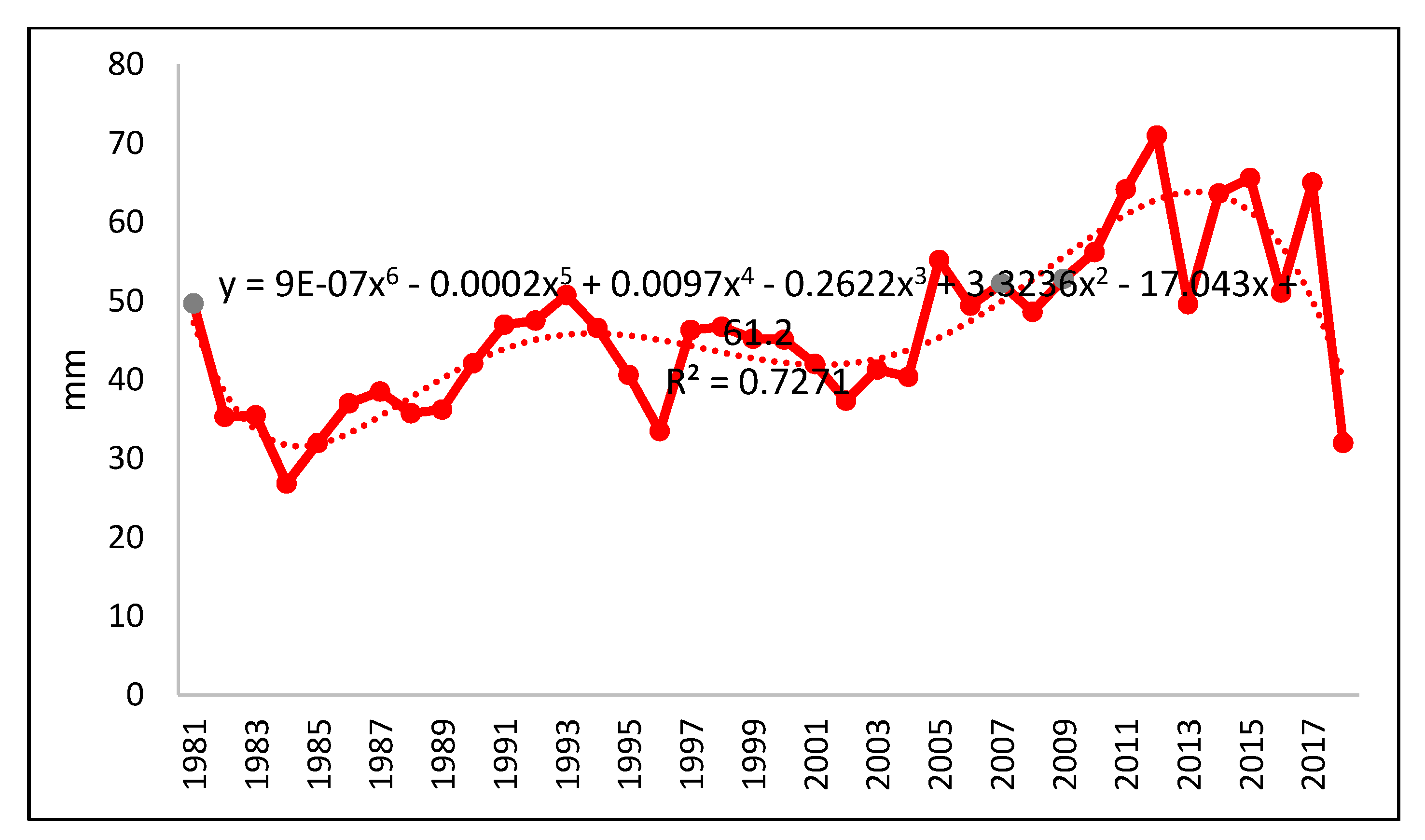

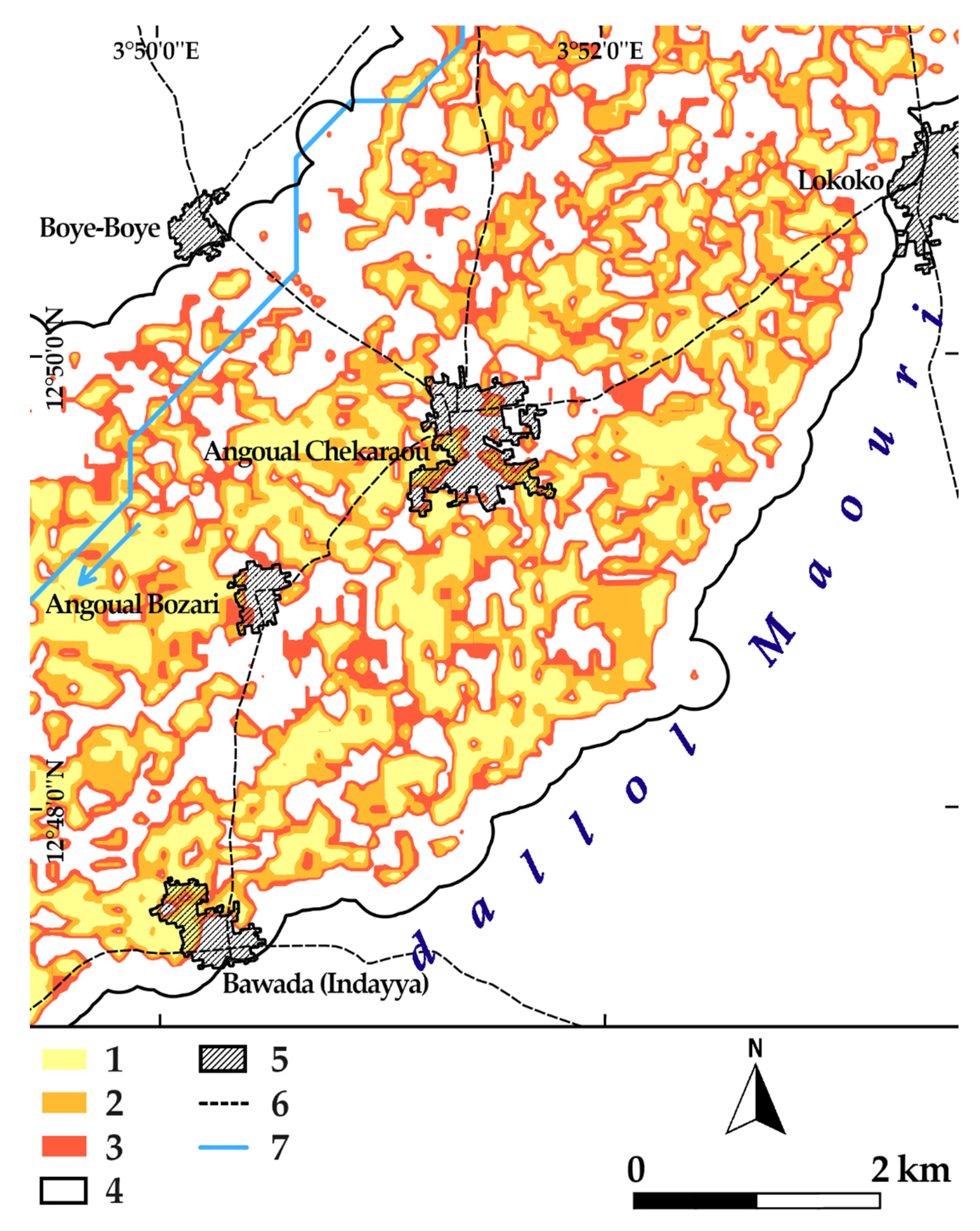

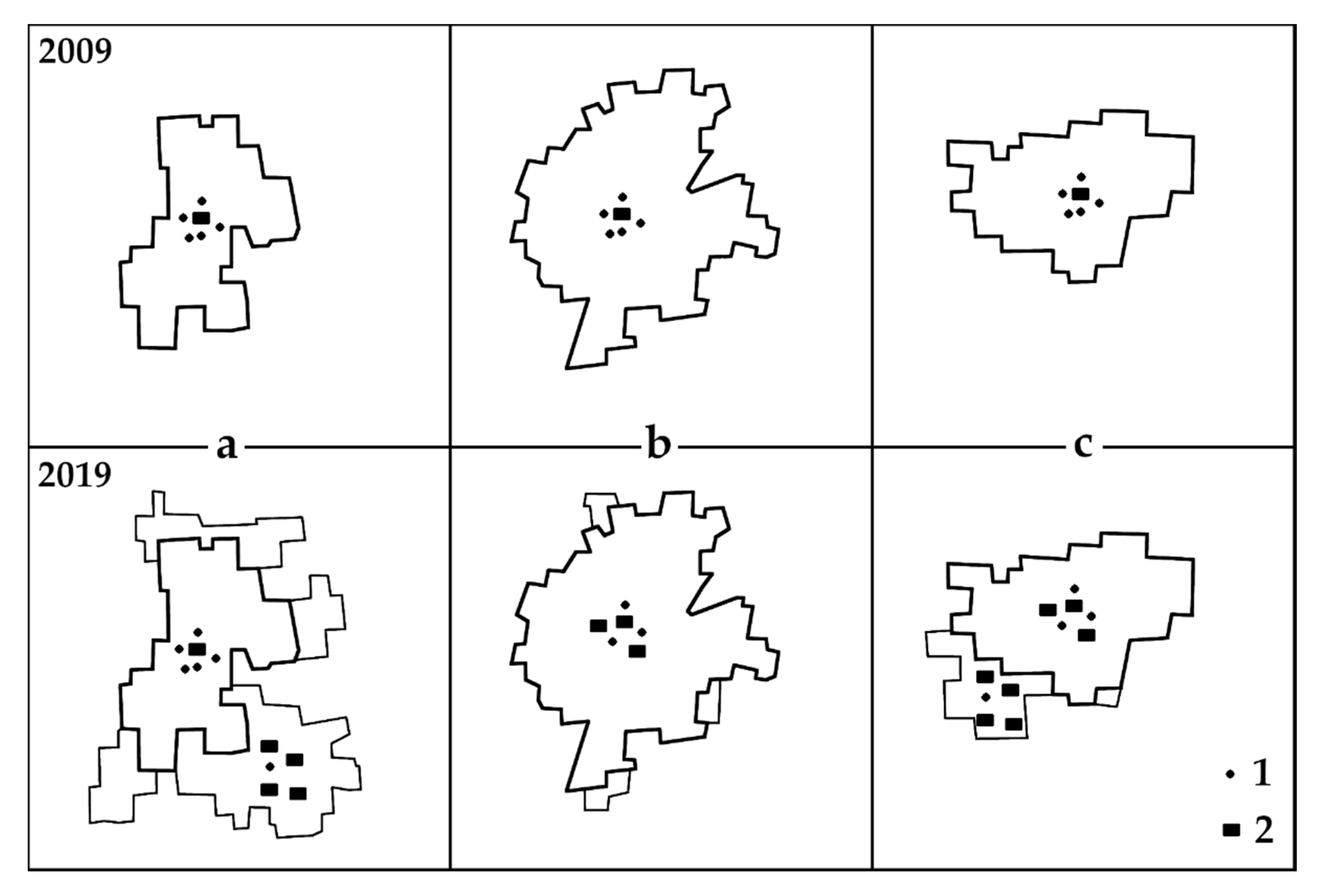

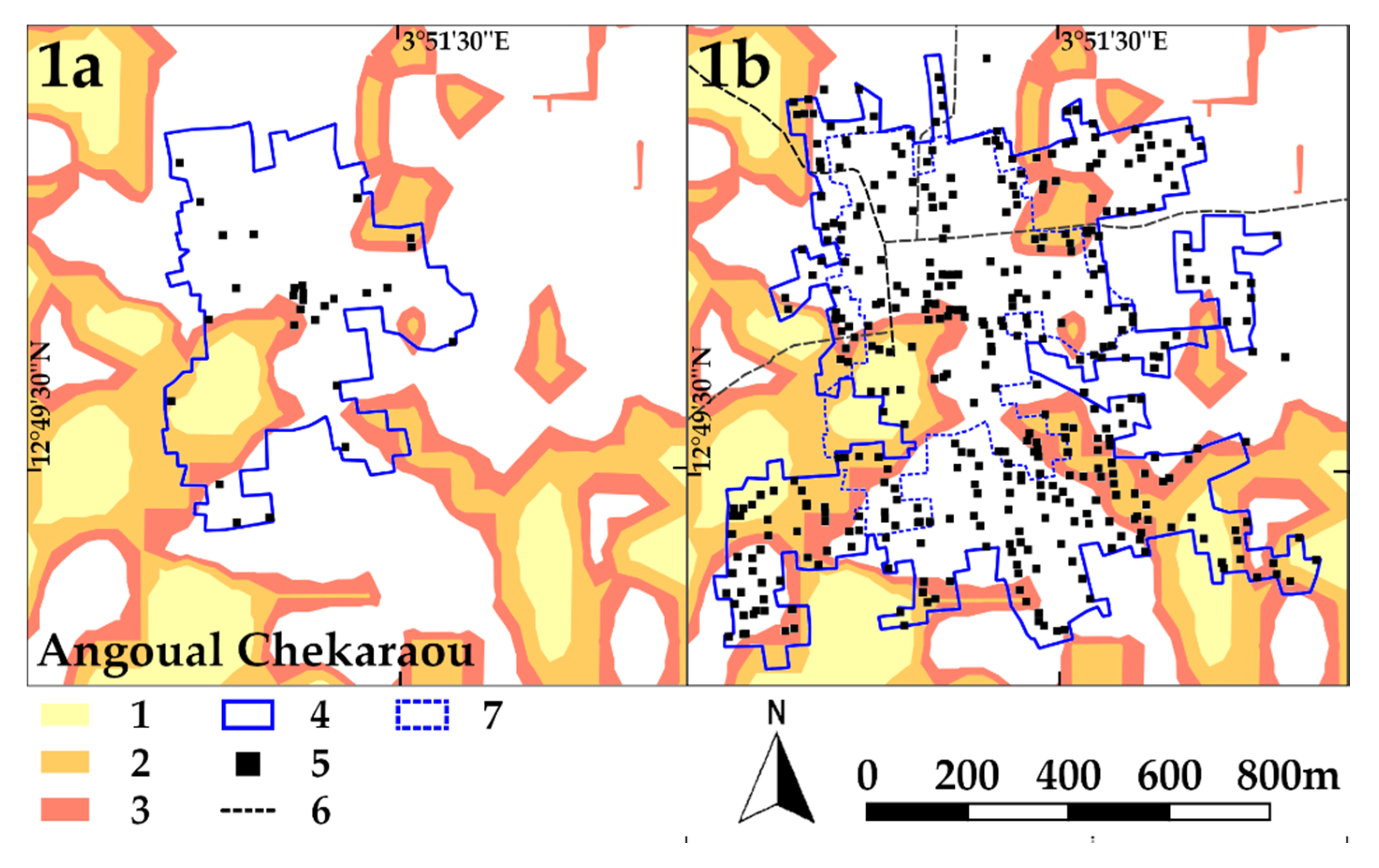

| Acronyms | Full Names |
|---|---|
| FPA | Flood-prone areas |
| NFPA | Non-flood-prone areas |
| DEM | Digital elevation model |
| DMN | Direction de la Météorologie Nationale du Niger |
| BDINA | Base de Données sur les Inondations Niger ANADIA |
| HydroSHEDS | Hydrological data and maps based on shuttle elevation derivates at multiple scales |
| Probability density functions | |
| RP | Return period |
| HEC-HMS | Hydrologic Engineering Center - hydrologic modeling system |
| HEC-RAS | Hydrologic Engineering Center - river analysis system |
| CN | Curve number |
| SAM | Spectral angle mapper |
| NDBI | Normalized difference built-up index |
| NDVI | Normalized difference vegetation index |
| Image Dataset | Year | Acquisition Date | Sensor | Spectral Resolution | Geometric Resolution | Format |
|---|---|---|---|---|---|---|
| 1 | 2009 | 6–14 October | GeoEye-1 | 4 bands | 0.5 m | Bundle 1 |
| 2 | 2019 | 1–6 September | WorldView-2 | 8 bands | 0.5 m | Bundle |
| Size Classes | Settlements |
|---|---|
| ha | n. |
| ≥50 | 1 |
| 10.00–49.99 | 6 |
| 2.00–9.99 | 21 |
| <2 | 59 |
| All | 87 |
| RP Years | Rainfall mm | QMAX l/s·km2 | Flood-Prone Area | VMEAN m/s | VMAX m/s | DMEAN m | DMAX m | |
|---|---|---|---|---|---|---|---|---|
| km2 | % | |||||||
| 2 | 133 | 2.73 | 25.2 | 12.5 | 0.14 | 0.43 | 0.63 | 1.34 |
| 20 | 217 | 9.02 | 48.1 | 23.9 | 0.26 | 0.73 | 0.84 | 1.67 |
| 200 | 287 | 18.05 | 66.7 | 33.2 | 0.33 | 0.85 | 0.97 | 1.78 |
| Year | Catastrophic Floods | |
|---|---|---|
| Community Remembrance | BDINA | |
| 2012 | X | X |
| 2013 | X | |
| 2015 | X | X |
| 2016 | X | X |
| Settlements in | 2009 | 2019 | ∆2009–2019 |
|---|---|---|---|
| no. | no. | % | |
| Non-flood-prone area | 45 | 51 | +13 |
| Flood-prone area | 36 | 36 | +0 |
| All | 81 | 87 | +7 |
| Settlements | In the Non-Flood-Prone Area | In the Flood-Prone Area | ||||
|---|---|---|---|---|---|---|
| 2009 | 2019 | ∆2009–2019 | 2009 | 2019 | ∆2009–2019 | |
| Area (ha) | 76.16 | 99.36 | +30% | 88.09 | 150.58 | +71% |
| Buildings (n.) | 3566 | 3578 | +0% | 3096 | 3760 | +21% |
| Density (build./ha) | 46.8 | 36.0 | −23% | 35.1 | 24.8 | −29% |
| Roof | 2009 | 2019 | ∆2009–2019 | ||
|---|---|---|---|---|---|
| no. | % | no. | % | % | |
| Straw | 2369 | 36 | 886 | 12 | −63 |
| Mud | 4067 | 61 | 4867 | 67 | +20 |
| Corrugated iron sheet | 226 | 3 | 1564 | 21 | +592 |
| Total | 6662 | 100 | 7317 | 100 | +10 |
| Flood Exposure | 2009 | 2019 | ∆2009–2019 | Consolidation Factor 1 | |
|---|---|---|---|---|---|
| no. | no. | % | - | ||
| Buildings | Total | 3096 | 3740 | +21 | - |
| RP2 | 474 | 540 | +14 | 0.94 | |
| RP20 | 755 | 932 | +23 | 1.02 | |
| RP200 | 1030 | 1327 | +29 | 1.07 | |
| % in the flood-prone area 2 | 33% | 35% | - | - | |
| Corr. iron sheet | Total | 115 | 815 | +609 | - |
| RP2 | 11 | 99 | +800 | 1.27 | |
| RP20 | 25 | 194 | +676 | 1.09 | |
| RP200 | 37 | 294 | +695 | 1.12 | |
| % in the flood-prone area 2 | 32% | 36% | - | - | |
| Dynamics | a Expansion | b Consolidation | c Expansion + Consolidation | |||
|---|---|---|---|---|---|---|
| Significant Settlements | Angoual Chekaraou | Lokoko | Toullou | |||
| Data | 2009 | ∆2009–2019 | 2009 | ∆2009–2019 | 2009 | ∆2009–2019 |
| Area (ha) | 28.6 | +147% | 38.9 | +22% | 5.7 | +35% |
| Buildings (no.) | 416 | +108% | 1599 | −6% | 285 | +9% |
| Corrugated iron sheets (no.) | 28 | +1318% | 68 | +410% | 8 | +350% |
| Straw (no.) | 75 | −91% | 771 | −85% | 125 | −60% |
| % in the flood-prone area | 18 | +7pp 1 | - | - | 54 | +0pp |
| Settlement | Area 2019 | Buildings 2019 | Iron Sheet Roofs 2019 | |||
|---|---|---|---|---|---|---|
| Total | In the Flood-Prone Area | Total | In the Flood-Prone Area | Total | In the Flood-Prone Area | |
| ha | % | no. | % | no. | % | |
| Dakora | 2.69 | 49 | 150 | 49 | 10 | 50 |
| Angoual Chekaraou | 70.71 | 31 | 866 | 25 | 397 | 31 |
| Illela Tounga Alou 1 | - | - | - | - | - | - |
| Angoual Bozari | 16.92 | 21 | 517 | 18 | 58 | 21 |
| Bawada (Indayya) | 32.95 | 45 | 1047 | 38 | 205 | 40 |
| Katamawa | 5.41 | 38 | 196 | 41 | 31 | 23 |
| Guizarawa | 5.07 | 28 | 227 | 19 | 19 | 47 |
| Toullou | 7.69 | 59 | 310 | 54 | 36 | 78 |
| Balsando | 4.44 | 20 | 226 | 21 | 40 | 25 |
| Tounga Atta | 2.5 | 100 | 145 | 100 | 7 | 100 |
| #49 2 | 0.85 | 100 | 11 | 100 | 4 | 100 |
| #54 | 1.35 | 94 | 45 | 91 | 8 | 75 |
| Lokoko | 47.51 | - | 1510 | - | 347 | - |
| Tounga Tombo | 3.22 | - | 129 | - | 65 | - |
| Tounga Nassara | 3.44 | - | 146 | - | 15 | - |
| Tounga Maizaki | 1.95 | - | 77 | - | 10 | - |
| Tounga Mai Zongo | 0.41 | - | 19 | - | 7 | - |
| Yangana | 3.44 | - | 158 | - | 27 | - |
| Angoual Kade | 4.86 | - | 212 | - | 47 | - |
| Boye-Boye | 15.19 | - | 547 | - | 107 | - |
| Tapkin Inoua | 5.25 | - | 273 | - | 30 | - |
| Tounga Makada | 3.01 | - | 111 | - | 13 | - |
| Here Damchi | 10.53 | - | 385 | - | 80 | - |
| #60 | 0.55 | - | 11 | - | 1 | - |
© 2020 by the authors. Licensee MDPI, Basel, Switzerland. This article is an open access article distributed under the terms and conditions of the Creative Commons Attribution (CC BY) license (http://creativecommons.org/licenses/by/4.0/).
Share and Cite
Galligari, A.; Giulio Tonolo, F.; Massazza, G. Floodplain Settlement Dynamics in the Maouri Dallol at Guéchémé, Niger: A Multidisciplinary Approach. Sustainability 2020, 12, 5632. https://doi.org/10.3390/su12145632
Galligari A, Giulio Tonolo F, Massazza G. Floodplain Settlement Dynamics in the Maouri Dallol at Guéchémé, Niger: A Multidisciplinary Approach. Sustainability. 2020; 12(14):5632. https://doi.org/10.3390/su12145632
Chicago/Turabian StyleGalligari, Andrea, Fabio Giulio Tonolo, and Giovanni Massazza. 2020. "Floodplain Settlement Dynamics in the Maouri Dallol at Guéchémé, Niger: A Multidisciplinary Approach" Sustainability 12, no. 14: 5632. https://doi.org/10.3390/su12145632
APA StyleGalligari, A., Giulio Tonolo, F., & Massazza, G. (2020). Floodplain Settlement Dynamics in the Maouri Dallol at Guéchémé, Niger: A Multidisciplinary Approach. Sustainability, 12(14), 5632. https://doi.org/10.3390/su12145632






